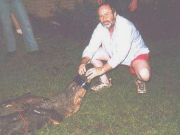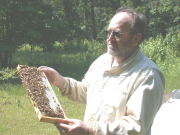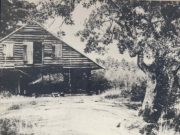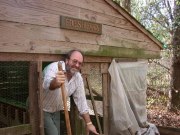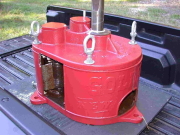|
Raymond Roland (Nashville, Georgia) Raymond Roland carries on his family's tradition of commercial cane-syrup production. His product, "Roland's Pride," is a blend of cane syrup and corn syrup and is sold in various local outlets. As Mr. Baldree did, Raymond noted that his customers prefer the somewhat less strongly flavored blend, and, of course, blending with fructose prevents granulation. It is my impression that Raymond's operation is one of the three largest in the South Georgia/North Florida area (with the other two being Mr. Charles Baldree's and Linda Paulk's). Mr. Roland and several employees were in full-scale operation the day of my visit. Regardless, he graciously made time for me, and I appreciate his explanation of his operation. Slide 1 is a view of the wagons of cane ready for grinding. Slides 2 and 3 provide an overview of the grinding operation. Wagons of cane are pulled under a shed extending from the syrup house. A Golden No.36 is stationed at the edge of the shed, so that cane is fed directly from the wagon into the mill. The bagasse is moved by conveyor to a large truck and subsequently used as cow fodder. The mill is driven by a tractor pto. The drive train includes a school-bus transmission. Mr. Roland explained that having a reverse gear is helpful when the mill becomes clogged. Slides 4 and 5 are views from under the shed. Only natural lighting was used and strong contrasts are inevitable with fast-speed film used for combinations of light and shadow. Sorry. Regardless, the slides provide some further detail. For example, Raymond uses a trio of modern belts to replace the traditional flat belt that was used to drive the mill pulley.
Slides 7, 8, and 9, show the three kettles used to produce Roland's Pride. Note the piped system used to deliver the juice from the warming pan that sits on a section of the furnace. Also, note how the kettle is mounted into the furnace. The furnace itself has an inward-sloping concrete edge that blends into the kettle flange, providing a larger area for the removal of skimming. Raymond's burners are the simplest I've seen he has a galvanized-pipe T with short nipples, each about 2-3 inches long. Each of the nipples has a single 1/8-inch hole drilled into it. |
